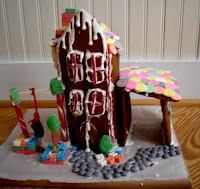
There are some things about Maine that just say Maine. Many of us make gingerbread for the holidays. We make Gingerlobsters. Here's how it happened.
Every Christmas we choose a different country and try to find a Christmas tradition from that country that will bring an element of international discovery & appreciation to our fairly modest family celebration. Last year we celebrated "France. We exchanged French themed gifts and made a Buche Noel. This year we celebrated "Germany". We talked about the Christmas tree or bough being an everlasting symbol of good fortune, and, trekked into the Maine woods (actually a farm up the road owned by a Bronx-born Jewish guy who has lived here 20+ years and harvests Xams trees) and of course made a gingerbread house. Food figures prominently in any of our family get togethers.
 The well-planned gingerbread event began before Christmas, in order to insure a successful project. I made sure the Maine pantry would be stocked with the baking goods we don't usually keep. Blackstrap molasses,* 10-X sugar, cloves (decided to use the whole ones & grate them, rather than spend $7.20 for a teeny tiny plastic supermarket spice jar of them. Emily came up with the idea of grinding them in the coffee bean grinder & it worked like a charm. Coffee should have that je ne sais qua flavor the next time we grind beans in that thing. Anyway. Emily went to THE candy store in NYC, the Economy Candy Store on Rivington Street, for great decorating candies like, Necco wafers, red string licorice, gray colored M&Ms, & smarties that look like minature lego blocks. So we made the gingerbread house.
The well-planned gingerbread event began before Christmas, in order to insure a successful project. I made sure the Maine pantry would be stocked with the baking goods we don't usually keep. Blackstrap molasses,* 10-X sugar, cloves (decided to use the whole ones & grate them, rather than spend $7.20 for a teeny tiny plastic supermarket spice jar of them. Emily came up with the idea of grinding them in the coffee bean grinder & it worked like a charm. Coffee should have that je ne sais qua flavor the next time we grind beans in that thing. Anyway. Emily went to THE candy store in NYC, the Economy Candy Store on Rivington Street, for great decorating candies like, Necco wafers, red string licorice, gray colored M&Ms, & smarties that look like minature lego blocks. So we made the gingerbread house.The original design called for several San Franciso type "painted ladies" houses with elaborate "frosting" detail. Once the project got underway, we compromised. Our house wound up being a tall Suburban, Anywhere, USA style house with attached car port ("they all have carports in Austin"), several "shrubs" and a tire swing (my favorite part) made with a Joyva Ring Jel (minature chocolate donut with red jelly inside), from, you guessed it, the Economy Candy Company on Rivington Street in NYC. We are all rather proud of this gingerbread house.
 Being the creative bunch we are, we decided to make Gingerbread cookies to adore the Christmas tree with the leftover dough. Hmmmmmmmm. Shapes. Men, Women, Animals? Maine........hmmmmmmm. Lobsters! of course. We love 'um. WE even have them on our license plates up here.
Being the creative bunch we are, we decided to make Gingerbread cookies to adore the Christmas tree with the leftover dough. Hmmmmmmmm. Shapes. Men, Women, Animals? Maine........hmmmmmmm. Lobsters! of course. We love 'um. WE even have them on our license plates up here. And in keeping with the holiday tradition, we share. These cookies/Xmas ornaments have traveled to Texas & LA post-Christmas, carefully wrapped to survive plane travel, to be delivered as unique holiday gifts to others less fortunate than us i.e. they didn't spend Christmas in Maine.
*(my favorite molasses trivia) The Boston Molasses Disaster, also known as the Great Molasses Flood or The Great Boston Molasses Tragedy, occurred on January 15, 1919, in the North End neighborhood of Boston, Mass. A large molasses tank burst and a wave of molasses rushed through the streets at an estimated 35 mph (56 km/h), killing 21 and injuring 150. The event has entered local folklore, and residents claim that on hot summer days the area still smells of molasses.
*(my favorite molasses trivia) The Boston Molasses Disaster, also known as the Great Molasses Flood or The Great Boston Molasses Tragedy, occurred on January 15, 1919, in the North End neighborhood of Boston, Mass. A large molasses tank burst and a wave of molasses rushed through the streets at an estimated 35 mph (56 km/h), killing 21 and injuring 150. The event has entered local folklore, and residents claim that on hot summer days the area still smells of molasses.